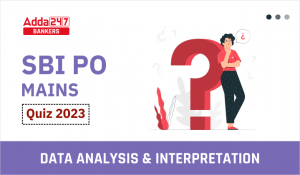Q1. Increase in remittances from non-resident Indians suggest—
(a) Increase in the balance of payments deficit in India
(b) Reduces the balance of payments deficit in India
(c) Has no effect on the balance of payments position
(d) All of the above
(e) None of the given options is true
S1. Ans.(b)
Sol. Reduces the balance of payments deficit in India.
Q2. Which of the following is not a method of credit control?
(a) Cash reserve ratio
(b) Open market operations
(c) Credit deposit ratio
(d) Bank rate policy
(e) None of the given options is true
S2. Ans.(c)
Sol. Credit deposit ratio is not a method of credit control.
Q3. The interest rate at which the RBI lends to commercial banks in the short term to maintain liquidity is known as—
(a) Interest rate
(b) Repo rate
(c) Reverse repo rate
(d) Bank rate
(e) Reverse Repo rate
S3. Ans.(b)
Sol. RBI lends to commercial banks in the short term to maintain liquidity is known as Repo rate.
Q4. What are the cooperative banks at the village level known as?
(a) Central cooperative banks
(b) Primary agricultural cooperative societies
(c) Village cooperative banks
(d) State cooperative banks
(e) None of the given options is true
S4. Ans.(b)
Sol. Primary agricultural cooperative societies.
Q5. Which nationalized bank was the first to sponsor a regional rural bank in India?
(a) Syndicate Bank
(b) Bank of India
(c) Union Bank of India
(d) Central Bank of India
(e) State Bank of India
S5. Ans.(a)
Sol. Syndicate Bank sponsored the first regional rural bank in India by name Prathama Bank in Moradabad district, Uttar Pradesh.
Q6. The EBRD is an international financial institution. EBRD stands for-
(a) European Basel for Reconstruction and Development
(b) European Bank for Reconstruction and Department
(c) European Bank for Reconstruction and Development
(d) English Bank for Reconstruction and Development
(e) European Basic for Reconstruction and Development
S6. Ans.(c)
Sol. The European Bank for Reconstruction and Development (EBRD) is an international financial institution founded in 1991.
Q7. Where is the Head Office of EBRD?
(a) Rome
(b) Vienna
(c) Berlin
(d) Geneva
(e) London
S7. Ans.(e)
Sol. The European Bank for Reconstruction and Development is an international financial institution founded in 1991. As a multilateral developmental investment bank, the EBRD uses investment as a tool to build market economies. The Head Office of EBRD is in London, UK.
Q8. IIB is a multilateral institution for development that promotes social and economic development, prosperity, and economic cooperation between its member states. IIB stands for-
(a) International Investment Bank
(b) International Indian Bank
(c) International Installment Bank
(d) International Institution Bank
(e) International Important Bank
S8. Ans.(a)
Sol. The International Investment Bank (IIB) is a multilateral institution for development that promotes social and economic development, prosperity, and economic cooperation between its member states. Main directions for its activities are the support of the small and medium-sized businesses and participation in financing socially significant infrastructure projects. The Bank provides loans primarily through leading domestic publicly owned financial institutions, development banks, export and import banks and agencies, or lends in partnership with other international institutions for development.
Q9. African Development Bank is coordinating the implementation of an integrated development strategy for Portuguese-speaking countries in Africa. In which among the following year African Development Bank was founded?
(a) 1984
(b) 1977
(c) 1972
(d) 1963
(e) 1967
S9. Ans.(d)
Sol. The African Development Bank (AfDB) Group is a regional multilateral development finance institution established to contribute to the economic development and social progress of African countries that are the institution’s Regional Member Countries (RMCs). The AfDB was founded following an agreement signed by member states on August 14, 1963, in Khartoum, Sudan, which became effective on September 10, 1964. The AfDB comprises three entities: the African Development Bank (ADB), the African Development Fund (ADF) and the Nigeria Trust Fund (NTF).
Q10. Where is the head office of African Development Bank?
(a) Ouagadougou
(b) Abidjan
(c) Porto-Novo
(d) Accra
(e) Bamako
S10. Ans.(b)
Sol. The head office of African Development Bank is in Abidjan, Cote d’Ivoire.
Q11. CBLO is a money market instrument that represents an obligation between a borrower and a lender as to the terms and conditions of a loan. What is the meaning of “B” in CBLO?
(a) Borrowing
(b) Balance
(c) Banking
(d) Basel
(e) Bond
S11. Ans.(a)
Sol. A collateralized borrowing and lending obligation (CBLO) is a money market instrument that represents an obligation between a borrower and a lender as to the terms and conditions of a loan.
Q12. MDR is a fee charged from a merchant by a bank for accepting payments from customers through credit and debit cards in their establishments. MDR stands for-
(a) Merchant Discount Ratio
(b) Merchant Discount Rate
(c) Merchant Discount Rating
(d) Merchant Development Rate
(e) Money Discount Rate
S12. Ans.(b)
Sol. MDR or Merchant Discount Rate is a fee charged from a merchant by a bank for accepting payments from customers through credit and debit cards in their establishments.
Q13. CRR is the amount of funds that the banks have to keep with the RBI. What is the full form of CRR?
(a) Cash Rate Ratio
(b) Cash Reserve Rate
(c) Cash Reserve Ratio
(d) Common Reserve Ratio
(e) Core Reserve Ratio
S13. Ans.(c)
Sol. Cash Reserve Ratio (CRR) is the amount of funds that the banks have to keep with the RBI.
Q14. MSF rate refers to the rate at which the scheduled banks can borrow funds overnight from RBI against government securities. What is the meaning of “F” in MSF?
(a) Funded
(b) Financial
(c) Flow
(d) Facility
(e) Fund
S14. Ans.(d)
Sol. Marginal Standing Facility (MSF) rate refers to the rate at which the scheduled banks can borrow funds overnight from RBI against government securities.
Q15. ETFs are mutual funds listed and traded on stock exchanges like shares. ETFs stands for-
(a) Electronic Traded Funds
(b) Exchange Time Funds
(c) Exchange Traded Finance
(d) Exchange Traded Flows
(e) Exchange Traded Funds






 Daily Current Affairs Quiz 2025 19 Novem...
Daily Current Affairs Quiz 2025 19 Novem...
 Quantitative Aptitude Quiz For SBI PO Ma...
Quantitative Aptitude Quiz For SBI PO Ma...
 Inequalities Basic Reasoning Quiz for Al...
Inequalities Basic Reasoning Quiz for Al...








